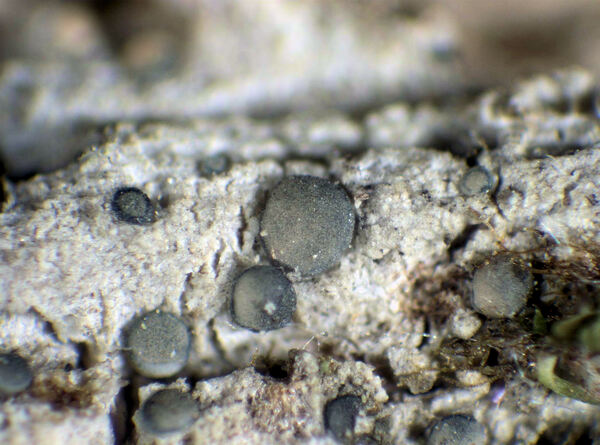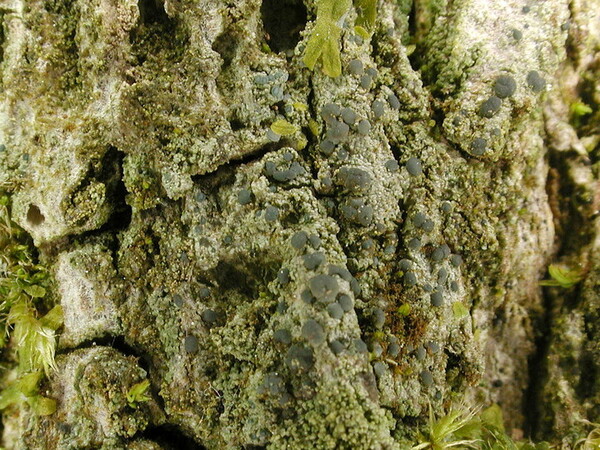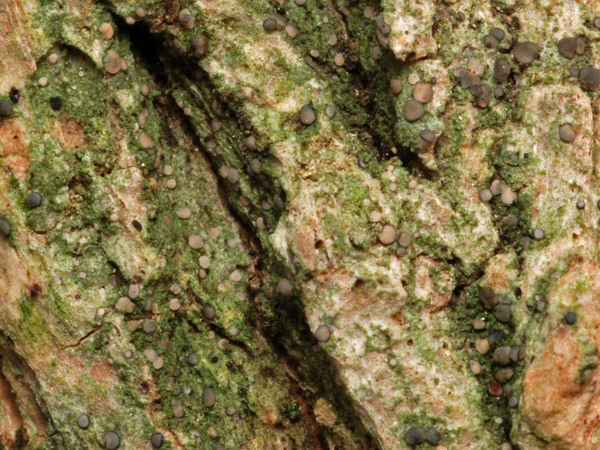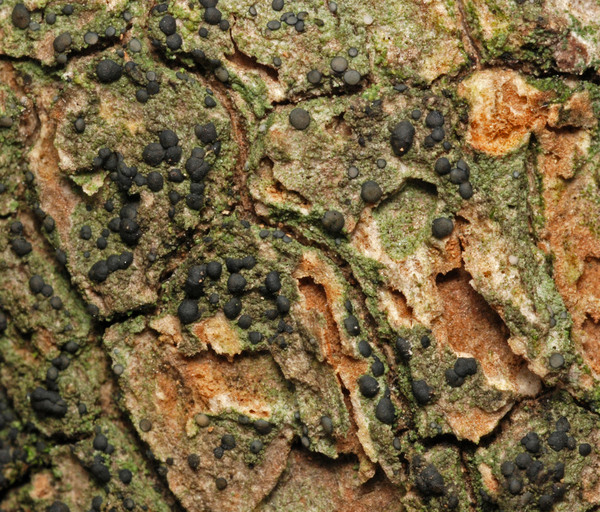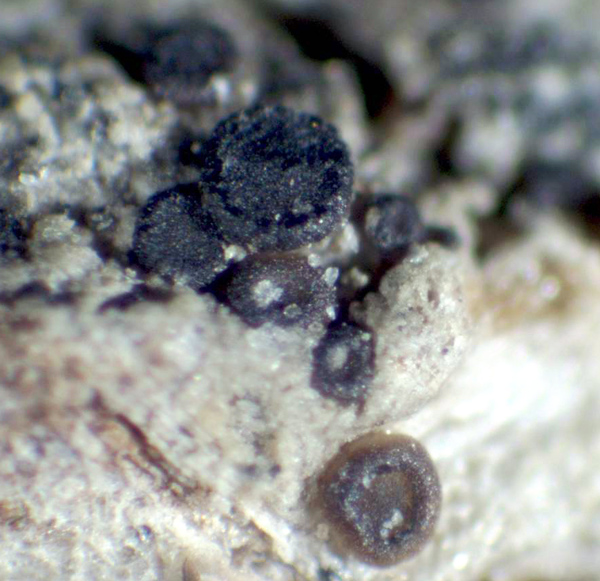Bacidina friesiana (Hepp) S. Ekman
Nordic J. Bot.: e03846, 30. 2023. Basionym: Biatora friesiana Hepp - Flecht. Eur.: nr. 288, 1857.
Synonyms: Bacidia friesiana (Hepp) Körb.; Lecidea norrlinii Lamy
Distribution: N - Frl, TAA (Nascimbene & al. 2007b), Lomb, Piem, Lig (Watson 2014). C - Tosc, Marc (Nimis & Tretiach 1999), Laz, Sar (Zedda 2002). S - Camp (Aprile & al. 2003b), Bas (Nimis & Tretiach 1999), Cal (Puntillo 1996).
Description: Thallus crustose, endosubstratic or thinly episubstratic, discontinuous or of discrete to contiguous, minutely subgranular, 0.2-0.8 mm wide areoles, whitish, pale grey or pale brown-grey, sometimes with a thin, endosubstratic, pale grey hypothallus. Apothecia biatorine, often aggregated, 0.2-0.8 mm across, piebald when mature but basically pale straw-coloured (not pink) mixed with grey to brown to almost black hues, with an initially flat, finally often convex, epruinose disc, and a concolorous to darker (especially when wet), often finally excluded proper margin. Proper exciple 50-60 μm wide laterally, yellowish with a grey, brown or blackish pigment concentrated in the outer upper part, with a single cell layer of globose, 3-6 µm wide cells, paler or colourless within, the pigmented parts K+ purplish, N+ orange-red; epithecium scarcely differentiated from the hymenium, pale brown, the pigmented parts K- and N+ purple; hymenium 40-65 μm high, colourless to pale brown in lower part, merging with the epithecium in upper part; paraphyses 1-1.5 μm thick at mid-level, the apical cells usually clavate, but sometimes weakly or not swollen, up to 5 μm wide; hypothecium colourless to very pale straw-coloured. Asci 8-spored, clavate to cylindrical-clavate, the apical dome K/I+ dark blue with a pale, conical-pointed apical cushion (axial mass) never penetrating through the entire d-layer, the wall K/I-, but the thin outer gel K/I+ blue, Bacidia-type. Ascospores (3-)7-9-septate, hyaline, needle-like, straight to sigmoid, 30-55(-70) x 2-3.5 μm, tapering towards one end. Pycnidia semi-immersed, 80-360 µm across, unilocular, strongly flattened and unpigmented except for a brown ring around the ostiole, which is finally widely gaping. Conidia thread-like, more or less curved, aseptate, 9-14 x c. 1 µm, formed terminally. Photobiont chlorococcoid, the cells 5-12 μm in diam. Spot tests: thallus K-, C-, KC-, P-, UV-. Chemistry: thallus without lichen substances; apothecia with the Laurocerasi-brown (major) and Bagliettoana-green (minor) pigments.
Note: a mild-temperate lichen, most frequent on Sambucus, or near the base of trees with nutrient-rich bark, with optimum in the submediterranean belt. Italian samples should be checked against the very similar B. caerulea (see Ekman 2023).
Growth form: Crustose
Substrata: bark
Photobiont: green algae other than Trentepohlia
Reproductive strategy: mainly sexual
Most common in areas with a humid-warm climate (e.g. most of Tyrrenian Italy)
Commonnes-rarity: (info)
Alpine belt: absent
Subalpine belt: absent
Oromediterranean belt: absent
Montane belt: extremely rare
Submediterranean belt: very rare
Padanian area: absent
Humid submediterranean belt: rare
Humid mediterranean belt: very rare
Dry mediterranean belt: absent

Predictive model
Herbarium samples

Source: Lee BG, Hur J-S (2022) A new species and four new records of Bacidia (Lecanorales, Ramalinaceae) from South Korea, with a key to Korean species. MycoKeys 93: 107-130. - CC BY-4.0
B. friesiana (KBA-L-0001914 for D–F) D habitus and apothecia. Thallus pale grey with slightly brownish pigment and pale pink apothecia E, F apothecial section with greenish epihymenium
Growth form: Crustose
Substrata: bark
Photobiont: green algae other than Trentepohlia
Reproductive strategy: mainly sexual
Most common in areas with a humid-warm climate (e.g. most of Tyrrenian Italy)
Commonnes-rarity: (info)
Alpine belt: absent
Subalpine belt: absent
Oromediterranean belt: absent
Montane belt: extremely rare
Submediterranean belt: very rare
Padanian area: absent
Humid submediterranean belt: rare
Humid mediterranean belt: very rare
Dry mediterranean belt: absent

Predictive model
| Herbarium samples |

 INDEX FUNGORUM
INDEX FUNGORUM
 GBIF
GBIF
 DOLICHENS
DOLICHENS
